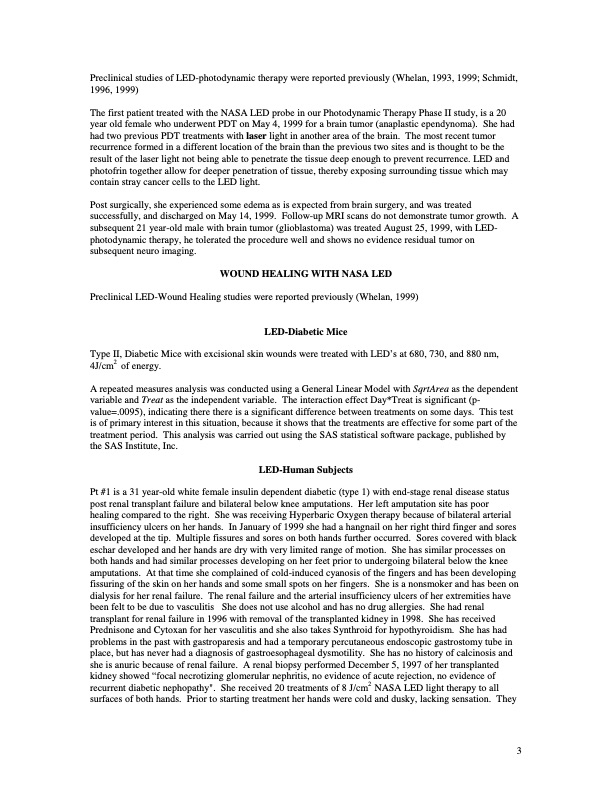
PDF Publication Title:
Text from PDF Page: 003
Preclinical studies of LED-photodynamic therapy were reported previously (Whelan, 1993, 1999; Schmidt, 1996, 1999) The first patient treated with the NASA LED probe in our Photodynamic Therapy Phase II study, is a 20 year old female who underwent PDT on May 4, 1999 for a brain tumor (anaplastic ependynoma). She had had two previous PDT treatments with laser light in another area of the brain. The most recent tumor recurrence formed in a different location of the brain than the previous two sites and is thought to be the result of the laser light not being able to penetrate the tissue deep enough to prevent recurrence. LED and photofrin together allow for deeper penetration of tissue, thereby exposing surrounding tissue which may contain stray cancer cells to the LED light. Post surgically, she experienced some edema as is expected from brain surgery, and was treated successfully, and discharged on May 14, 1999. Follow-up MRI scans do not demonstrate tumor growth. A subsequent 21 year-old male with brain tumor (glioblastoma) was treated August 25, 1999, with LED- photodynamic therapy, he tolerated the procedure well and shows no evidence residual tumor on subsequent neuro imaging. WOUND HEALING WITH NASA LED Preclinical LED-Wound Healing studies were reported previously (Whelan, 1999) LED-Diabetic Mice Type II, Diabetic Mice with excisional skin wounds were treated with LED’s at 680, 730, and 880 nm, 4J/cm2 of energy. A repeated measures analysis was conducted using a General Linear Model with SqrtArea as the dependent variable and Treat as the independent variable. The interaction effect Day*Treat is significant (p- value=.0095), indicating there there is a significant difference between treatments on some days. This test is of primary interest in this situation, because it shows that the treatments are effective for some part of the treatment period. This analysis was carried out using the SAS statistical software package, published by the SAS Institute, Inc. LED-Human Subjects Pt #1 is a 31 year-old white female insulin dependent diabetic (type 1) with end-stage renal disease status post renal transplant failure and bilateral below knee amputations. Her left amputation site has poor healing compared to the right. She was receiving Hyperbaric Oxygen therapy because of bilateral arterial insufficiency ulcers on her hands. In January of 1999 she had a hangnail on her right third finger and sores developed at the tip. Multiple fissures and sores on both hands further occurred. Sores covered with black eschar developed and her hands are dry with very limited range of motion. She has similar processes on both hands and had similar processes developing on her feet prior to undergoing bilateral below the knee amputations. At that time she complained of cold-induced cyanosis of the fingers and has been developing fissuring of the skin on her hands and some small spots on her fingers. She is a nonsmoker and has been on dialysis for her renal failure. The renal failure and the arterial insufficiency ulcers of her extremities have been felt to be due to vasculitis She does not use alcohol and has no drug allergies. She had renal transplant for renal failure in 1996 with removal of the transplanted kidney in 1998. She has received Prednisone and Cytoxan for her vasculitis and she also takes Synthroid for hypothyroidism. She has had problems in the past with gastroparesis and had a temporary percutaneous endoscopic gastrostomy tube in place, but has never had a diagnosis of gastroesophageal dysmotility. She has no history of calcinosis and she is anuric because of renal failure. A renal biopsy performed December 5, 1997 of her transplanted kidney showed “focal necrotizing glomerular nephritis, no evidence of acute rejection, no evidence of recurrent diabetic nephopathy". She received 20 treatments of 8 J/cm2 NASA LED light therapy to all surfaces of both hands. Prior to starting treatment her hands were cold and dusky, lacking sensation. They 3PDF Image | NASA Light-Emitting Diode Medical Program

PDF Search Title:
NASA Light-Emitting Diode Medical ProgramOriginal File Name Searched:
The_NASA_light-emitting_diode_medical_program-prog.pdfDIY PDF Search: Google It | Yahoo | Bing
Cruise Ship Reviews | Luxury Resort | Jet | Yacht | and Travel Tech More Info
Cruising Review Topics and Articles More Info
Software based on Filemaker for the travel industry More Info
The Burgenstock Resort: Reviews on CruisingReview website... More Info
Resort Reviews: World Class resorts... More Info
The Riffelalp Resort: Reviews on CruisingReview website... More Info
| CONTACT TEL: 608-238-6001 Email: greg@cruisingreview.com | RSS | AMP |